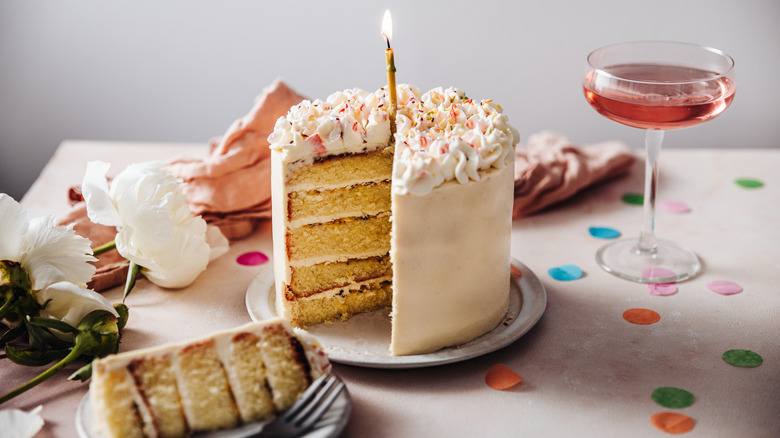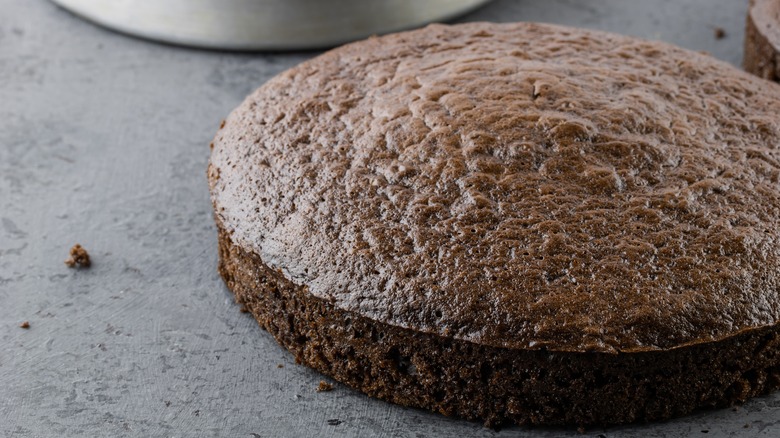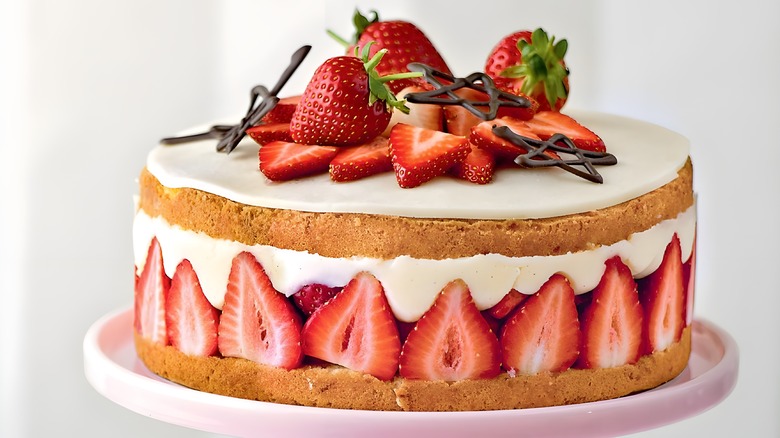The Right Way To Freeze Cake (And Make Frosting It Even Easier)
There's no better way to celebrate a special occasion than with cake. However, baking a cake can be inconveniently time-consuming, especially when you're trying to plan other aspects of a special event. The good news is that cakes freeze well, allowing you to skip the stress by getting your baking done ahead of time and freezing your cake until you're ready to decorate and serve it. Rather than scrambling in the kitchen on the day of a big party, you can rest assured knowing that your dessert is ready to go.
While freezing a cake might seem as simple as sticking it in the freezer, there are a couple of things you should know before taking advantage of this hack. For example, certain types of frosting freeze better than others, and a cake should be cooled completely before you transfer it to the freezer.
There are several different ways to go about freezing a cake, but storing the individual layers unfrosted and unassembled is arguably the best method. This allows you to tightly wrap the layers in plastic wrap and aluminum foil, which prevents freezer burn and preserves the cake's moisture and flavor. Exposing your cake to outside air will dry it out, so don't be afraid to use several layers of plastic wrap and aluminum foil.
How to freeze any kind of cake
With layered cakes, you can store the layers on top of each other once wrapped, either on a baking sheet or in a freezer-safe container. Don't transfer the cake to the freezer until it has cooled completely. A still-warm cake will cause condensation to form inside the plastic wrap, affecting the cake's flavor and texture as the moisture freezes. The process is the same for loafs, bundts, or angel food cakes that don't have separate layers.
Freezing a cake can make it easier to frost. Partially frozen cakes are stiffer, which means they produce fewer crumbs and are easier to decorate. That said, you don't want your cake to be too frozen when you start frosting. If the cake is too cold, it will chill the frosting, making it difficult to spread. To thaw a frozen cake, move it to the refrigerator the night before you plan to decorate it. Do the same with your icing if you froze that as well. Then let the frosting sit at room temperature until it is sufficiently soft.
For most types of frosting, freezing an already-frosted cake is also an option. (A few types of icing, including glazes and meringue-based frostings, don't freeze well.) To freeze a frosted cake, place it in the freezer on a plate or baking sheet uncovered until it is sufficiently frozen. This should take about an hour or so, depending on its size. You'll know the cake is frozen enough when you can touch the frosting without any coming off on your finger. At that point, wrap the entire cake in plastic wrap and aluminum foil.
How long can you freeze cake?
Unsurprisingly, the sooner you serve your frozen cake, the fresher it will taste. However, when wrapped properly, most cakes can be stored in the freezer for up to three months. If you wait any longer than that, you'll notice that the flavor and texture start to diminish, so plan your freezing timeline accordingly.
When it comes to already frosted cake, the amount of time it can spend in the freezer varies depending on what type of frosting you've used. Buttercream frosting freezes very well and can be stored in the freezer for up to three months, either on your cake or in an airtight container on its own. Another benefit of buttercream frosting is that it doesn't freeze as solid as fondant icing due to its fat content, which makes for fewer cracks when the cake thaws. However, if you do end up with cracks, don't panic; there is an easy fix for cracked fondant. Simply pinch the edges of the crack together, dab a bit of shortening or another oil of your choice on the tear, and rub in a circular motion with your fingers until the crack is resealed. You can also cover larger tears with edible flowers or a layer of piping frosting.


